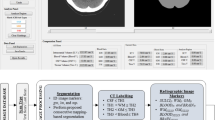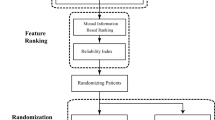Abstract
Purpose
This paper aims to estimate the intracranial pressure (ICP) in patients with traumatic brain injuries (TBI) noninvasively using directional features obtained from the texture of brain CT image and support vector regression (SVR) method.
Methods
A fully anisotropic Morlet wavelet transform is performed on brain CT images and optimal feature vectors have been extracted to classify the images into two groups of mild and severe TBI. Genetic algorithms with the fitness functions of support vector machines (SVM) classification accuracy rates have been used to find the optimal feature vector. Finally, SVR is implemented to estimate the ICP of patients with TBI. The results are compared to the ones obtained using Dual Tree complex wavelet transform based directional features.
Results
Features obtained from anisotropic continuous complex wavelet transform are shown to be effective in separating data from two classes of mild and severe TBI. The highest classification accuracy rate of 94.43 percent is achieved. Also, using SVR, the ICP estimation results demonstrate that the proposed algorithm yields excellent performance with a mean absolute error of 4.25 mmHg compared to Dual Tree complex wavelet transform features with the mean absolute error of 5.48 mmHg.
Conclusions
The severity of TBI is assessed non-invasively using brain CT images, and the directional textural features of brain tissue. The proposed algorithm using anisotropic Morlet wavelet features, GA-SVM based feature selection and SVR methods achieves an excellent performance in ICP estimation for TBI severity assessment.
Similar content being viewed by others
References
Langlois JA, Rutland-Brown W, Thomas KE. Traumatic brain injury in the United States: emergency department visits, hospitalizations, and deaths. Atlanta (GA): Centers for Disease Control and Prevention, National Center for Injury Prevention and Control, 2006.
Zhang W-L, Wang X-Z. Feature extraction and classification for human brain CT images. 6th Int Conf Mach Learn Cybern. Hong Kong. 2007; 2:1155–1159.
Ji S-Y, Smith R, Huynh T, Najarian K. A comparative analysis of multi-level computer-assisted decision making systems for traumatic injuries. BMC Med Inform Decis Mak. 2009; 9:2.
Kingsbury N. Complex wavelets for shift invariant analysis and filtering of signals. Appl Comput Harmon A. 2001; 10(3):234–253.
Aydogan DB, Hannula M, Arola T, Dastidar P, Hyttinen J. 2D texture based classification, segmentation and 3D orientation estimation of tissues using DT-CWT feature extraction methods. Data Knowl Eng. 2009; 68(12):1383–1397.
Chen W, Smith R, Nabizadeh N, Ward K, Cockrell C, Ha J, Najarian K. Texture analysis of brain CT scans for ICP prediction. Int Conf Image Signal Proc LNCS. 2010; 6234:568–575.
Aghazadeh BS, Khaleghi M, Pidaparti R, Najarian K. Intracranial pressure (ICP) level estimation using textural features of brain CT images. Comput Meth Biomech Biomed Eng. 2013; doi:10.1080/21681163.2013.773651.
Najarian K, Splinter R. Biomedical signal and image processing. Taylor and Francis CRC Press. 2006.
Kumar P. A wavelet based methodology for scale-space anisotropic analysis. Geophys Res Lett. 1995; 22(20):2777–2780.
Neupauer RM, Powell KL. A fully-anisotropic Morlet wavelet to identify dominant orientations in a porous medium. Comput Geosci. 2005; 31(4):465–471.
Holland JH. Adaptation in Natural and Artificial Systems. Michigan: University of Michigan Press; 1975.
Michalewicz Z. Genetic Algorithms + Data Structures =Evolution Programs. Berlin: Springer; 1996.
Xu P, Kasprowicz M, Bergsneider M, Hu X. Improved noninvasive intracranial pressure assessment with nonlinear kernel regression. IEEE T Inf Technol Biomed. 2010; 14(4): 971–978.
Author information
Authors and Affiliations
Corresponding author
Rights and permissions
About this article
Cite this article
Aghazadeh, B.S., Ansari, S., Pidaparti, R. et al. Non-invasive estimation of intracranial pressure in traumatic brain injury (TBI) using fully-anisotropic Morlet wavelet transform and support vector regression. Biomed. Eng. Lett. 3, 190–197 (2013). https://doi.org/10.1007/s13534-013-0102-2
Received:
Revised:
Accepted:
Published:
Issue Date:
DOI: https://doi.org/10.1007/s13534-013-0102-2




